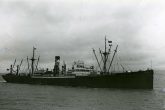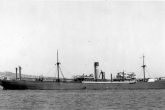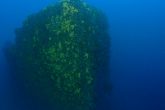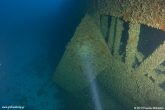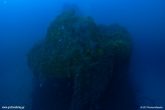Shipwreck S/S Petalli (ex Admiral Cochrane 1917)
The Greek cargo steam ship Petali (ex Admiral Cochrane) was constructed at the shipyard of William Doxford & Sons, at Pallion, Sunderland, England.
It was launched in May 19th 1917 and its construction was completed in September of the same year. It travelled under its first name, Admiral Cochrane, for the
Byron Steamship Co. Ltd, owned by Empirikos Brothers with its base in London until 1928 that it was given to the company of Maris A. Empirikos
with its base in Andros.
The general characteristics of the ship were:
Name: The initial name was Admiral Cochrane. In 1928, when it was included in the fleet of Maris A. Empirikos, its name changed to Petali.
DDS: SVBQ
Type: Cargo steam ship
First Flag: British
Last Flag: Greek
Total capacity: 6.565
Length: 128m
Width: 16,5m
Draught: 10,3m
Impulse: Three-cylinder reciprocating steam engine of 572 NHP, constructed by North East Marine Engineering Company Ltd., Sunderland, UK
Propellers: 1
Indicative Speed: 11,5 knots.
In November 1940,immediately after the beggining of the Greek-Italian War, Petali was commandeered by the Greek authorities to South Africa.
In April 6th 1941, when Germany started the War against Greece, the ship was docked at the port of Piraeus.
During the big bombing of Piraeus by the German air force and the explosion of Clan Fraser, Petali got fire and then it was towed outside the port
and it sank at Diavlos.
The wreck of Petali was identified as such in summer 2010 by the wreckdiving.gr team.
The wreck has a maximum depth of 74m. It is located in a distance of almost 120m and the axis bow-stern has a direction to the west.
The whole wreck has undergone many damages, it has been partially disfigured and in many parts the superstructures and the ship’s deck have collapsed.
In the middle of the ship, the remainings of the bridge are still discreet and exactly behind that, there are remainings of the superstructure of the engine room.
The entrance to that is accessible but, despite the tubes and the pipe installations, only few other objects are discreet.
At the same area, there is at least one davit that has collapsed and it is located on the roof of the engine room.
At the area of the stern, there is the poop and a triangle construction that has been transformed to a solid calcareous bulk.
This construction is actually the supports of the loaders of the ship.
The biggest part of the stern is covered by a net that has been transformed to a calcareous construction because of the continuous and long time overlays of the
sea organisms.
Bibliography and sources:
– The War Diary of the Royal Navy, Navy History Service, Votanikos, Athens
– Heeresoberkommando 12 Gen.-Kdo. VIII. Fl.-Korps-Ic, Nr.2121/41 geh.v.8.5.41
– Empirikos, August: The history of Empirikos Families, Athens, 1983
– Kavadias Epaminondas: The Navy War of 1940 as I lived it, Athens, 1950
– Malakassis Ioannis: The Navy during the Second World War, Volume I & II, Ioannina, 1995
– Ntounis Christos: The wrecks in the Greek Seas, editions Finatec 2001
– Petropoulos Nikos:Memories and thoughts of an old seaman, Volume ´ The War of 1940-1941, Athens 1966
– Fokas Demetrios: Essay on the action of the Royal Navy during the War of 1940-1944, Volume A: From the pre-war period to the takeover of Greece (27 April 1941),
Editions of the Historic Service of the Royal Navy 1953.
Video of the Archive: http://www.youtube.com/watch?v=p1IFviHkC3k


